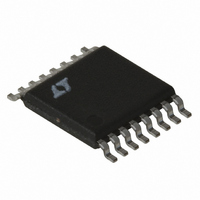LT1976EFE Linear Technology, LT1976EFE Datasheet - Page 26

LT1976EFE
Manufacturer Part Number
LT1976EFE
Description
IC REG SW STEP DWN 1.5A 16-TSSOP
Manufacturer
Linear Technology
Type
Step-Down (Buck)r
Datasheet
1.LT1976IFEPBF.pdf
(28 pages)
Specifications of LT1976EFE
Internal Switch(s)
Yes
Synchronous Rectifier
No
Number Of Outputs
1
Voltage - Output
1.2 ~ 54 V
Current - Output
1.5A
Frequency - Switching
200kHz
Voltage - Input
3.3 ~ 60 V
Operating Temperature
-40°C ~ 125°C
Mounting Type
Surface Mount
Package / Case
16-TSSOP Exposed Pad, 16-eTSSOP, 16-HTSSOP
Lead Free Status / RoHS Status
Contains lead / RoHS non-compliant
Power - Output
-
Available stocks
Company
Part Number
Manufacturer
Quantity
Price
Part Number:
LT1976EFE
Manufacturer:
LINEAR/凌特
Quantity:
20 000
Company:
Part Number:
LT1976EFE#PBF
Manufacturer:
IR
Quantity:
120
Part Number:
LT1976EFE#PBF
Manufacturer:
LINEAR/凌特
Quantity:
20 000
Company:
Part Number:
LT1976EFE#TRPBF
Manufacturer:
LT
Quantity:
1 560
Part Number:
LT1976EFE#TRPBF
Manufacturer:
LTNEAR
Quantity:
20 000
LT1976/LT1976B
APPLICATIO S I FOR ATIO
The LT1976 uses current mode control. This alleviates
many of the phase shift problems associated with the
inductor. The basic regulator loop is shown in Figure 12.
The LT1976 can be considered as two g
amplifier and the power stage.
Figure 13 shows the overall loop response with a 330pF V
capacitor and a typical 100μF tantalum output capacitor.
The response is set by the following terms:
The pole set by C
Unity gain frequency is set by C
Powerstage: DC gain is set by g
Pole set by C
Unity gain set by C
26
Error amplifier: DC gain is set by g
EA Gain = 650μ • 1.5M = 975
EA Pole = 1/(2π • 1.5M • 330pF) = 322Hz
EA Unity Gain Frequency = 650μF/(2π • 330pF)
PS DC Gain = 3 • 10 = 30
PS Pole = 1/(2π • 100μF • 10) = 159Hz
PS Unity Gain Freq = 3/(2π • 100μF) = 4.7kHz.
C
R
F
C
C
C
11
LT1976
V
CURRENT MODE
POWER STAGE
C
OUT
Figure 13. Model for Loop Response
g
m
= 3
F
and R
and R
OUT
Ω
U
Ω
g
1.6M
m
= 650μ
L
and g
:
L
ERROR
U
:
Ω
AMP
= 313kHz
m
+
–
:
m
F
and g
and R
W
1.26V
SW
FB
m
m
m
12
and R
L
2
blocks, the error
:
R1
R2
(assume 10Ω):
1976 F13
O
U
:
C
FB
ESR
C
OUTPUT
OUT
C
Tantalum output capacitor zero is set by C
ESR
The zero produced by the ESR of the tantalum output
capacitor is very useful in maintaining stability. If better
transient response is required, a zero can be added to the
loop using a resistor (R
capacitor. As the value of R
response will generally improve but two effects limit its
value. First, the combination of output capacitor ESR and
a large R
Second, if the loop gain is not rolled off sufficiently at the
switching frequency output ripple will perturb the V
enough to cause unstable duty cycle switching similar to
subharmonic oscillation. This may not be apparent at the
output. Small-signal analysis will not show this since a
continuous time system is assumed. If needed, an addi-
tional capacitor (C
typically one-fifth the switching frequency (if R
C
When checking loop stability the circuit should be oper-
ated over the application’s full voltage, current and tem-
perature range. Any transient loads should be applied and
the output voltage monitored for a well-damped behavior.
E
Output Capacitor Zero = 1/(2π • 100μF • 0.1) = 15.9kHz
= 1500pF, C
C
100
–50
50
0
may stop loop gain rolling off altogether.
10
Figure 14. Overall Loop Response
F
= 330pF)
100
F
) can be added to form a pole at
FREQUENCY (Hz)
C
) in series with the compensation
1k
V
C
C
R
I
LOAD
10k
OUT
OUT
F
L
C
/C
= 330pF
L
= 3.3V
= 100μF, 0.1Ω
is increased, transient
= 330mA
= NC
100k
1976 F14
1M
OUT
100
135
90
45
0
and C
C
= 10k,
C
1976bfg
OUT
pin











